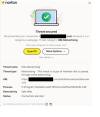HCHTech
Well-Known Member
- Reaction score
- 4,178
- Location
- Pittsburgh, PA - USA
I've got a client who's accountant is getting a warning from their installation of Norton every time they visit my client's website - as follows:

Note the URL flagged, it's the main website, but it's finding an autodiscover.xml file. The website guy (a referral partner of mine) says this file doesn't exist on the website and all of his scans of the site come back clean.
This sure sounds like a false positive from Norton, but why would it be picking up an autodiscover file on a website? Especially one that isn't really there. None of this is making any sense.

Note the URL flagged, it's the main website, but it's finding an autodiscover.xml file. The website guy (a referral partner of mine) says this file doesn't exist on the website and all of his scans of the site come back clean.
This sure sounds like a false positive from Norton, but why would it be picking up an autodiscover file on a website? Especially one that isn't really there. None of this is making any sense.
